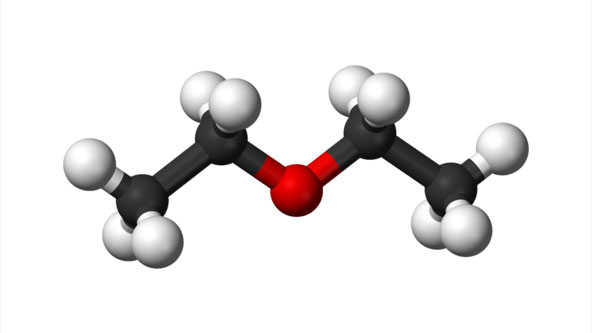What is Diethyl Ether?
Previously used as an anesthetic, Diethyl ether is an organic compound used primarily as a solvent. This colorless, highly volatile chemical has a pungent, yet somewhat sweet odor. Due to its extreme flammability and other potential hazards, diethyl ether should be stored and handled with extreme care in the workplace. Read on for our tips about handling and storing diethyl ether safely, and how to manage exposure and spills.
Common Uses of Diethyl Ether
Diethyl ether is produced through the combination of ethanol and sulfuric acid, and has a few major uses. This chemical is used as:
- A starting fluid in diesel and gasoline engines
- A laboratory solvent
- A solvent in the production of cellulose plastics
Health Hazards Associated with Diethyl Ether
Diethyl ether is a volatile chemical that can easily catch fire or even explode. Diethyl ether vapor can be ignited not only by an open flame but also by heat sources or even static electricity. In addition, it can produce explosive peroxides when exposed to light and air. This chemical also poses an inhalation hazard, and can cause irritation of the eyes and skin. Due to these hazards, it’s important to use caution whenever handling diethyl ether or being in its general vicinity.
Diethyl Ether Safety, Proper Handling & First Aid
When using diethyl ether in the workplace, only explosion-proof (group C) electrical equipment should be operated in the area. Access to appropriate fire-fighting equipment is a must. In the case of small fires, use dry chemical powder. In case of a large fire, use alcohol foam, water spray, or fog. Heated containers can be cooled with water jet to prevent pressure build-up, ignition or explosion.
Use adequate ventilation to avoid vapor accumulation. Ensure eyewash stations and safety showers are accessible, and use splash goggles, gloves, and an approved vapor respirator. In the event of exposure to diethyl ether, seek medical attention and follow these first aid guidelines:
- Inhalation – Seek fresh air. If victim’s breathing is difficult, administer oxygen. If breathing is absent, give artificial respiration and seek medical attention immediately.
- Eye Contact – Remove contact lenses if present. Immediately flush eyes with plenty of water for at least 15 minutes, seeking medical attention immediately.
- Skin Contact – Flush skin with plenty of water and cover irritated skin with an emollient. Remove contaminated clothing. In case of serious skin exposure, use an anti-bacterial cream and quickly seek out medical attention.
- Ingestion—Do NOT induce vomiting. Loosen any tight clothing. Never give anything by mouth to an unconscious person. Seek medical attention as soon as possible.
Storing & Disposing of Diethyl Ether
Do not store diethyl ether near powerful oxidizers or incompatible materials. Keep diethyl ether away from heat and sources of ignition, in a segregated area. Keep container tightly closed and sealed in a cool, well-ventilated area protected from light, moisture and air.
Learn More About Diethyl Ether Safety
Due to its severe health risks, this chemical must be disposed of in strict accordance with federal, state, and local environmental control regulations. Find out more about this and other chemicals in your workplace by browsing our database of MSDS information.
